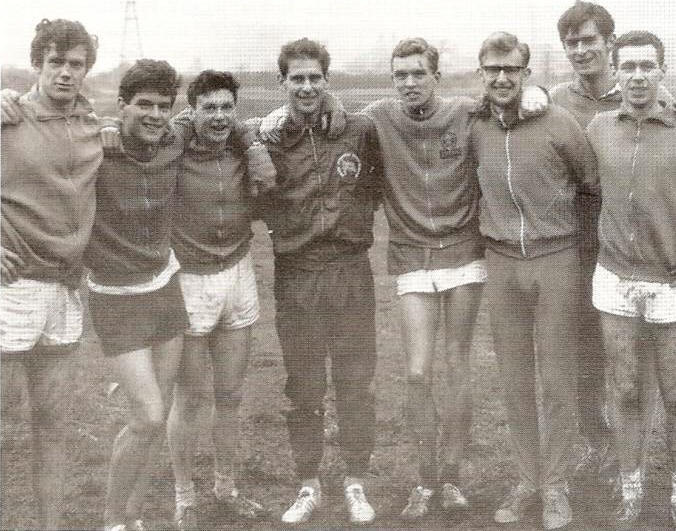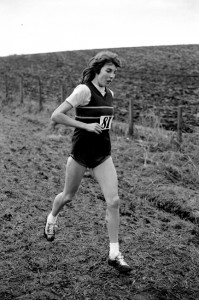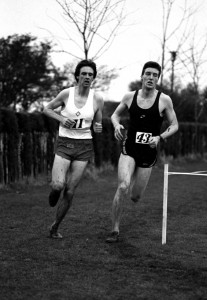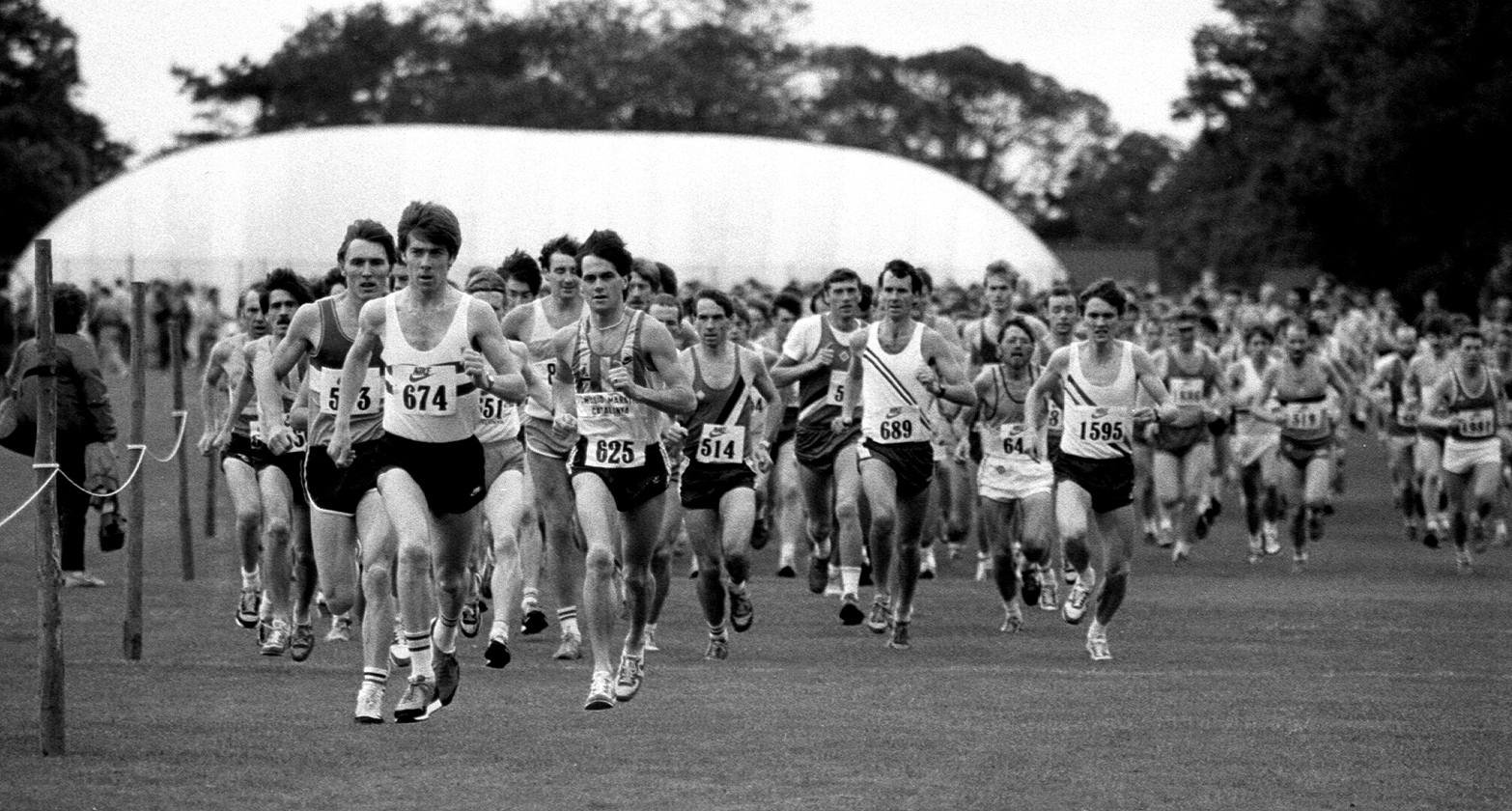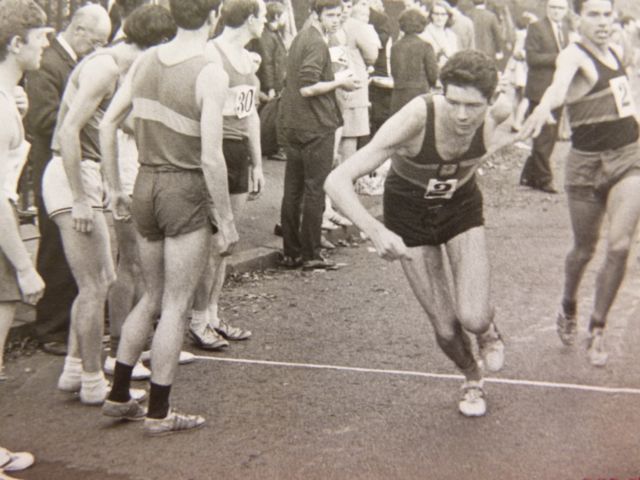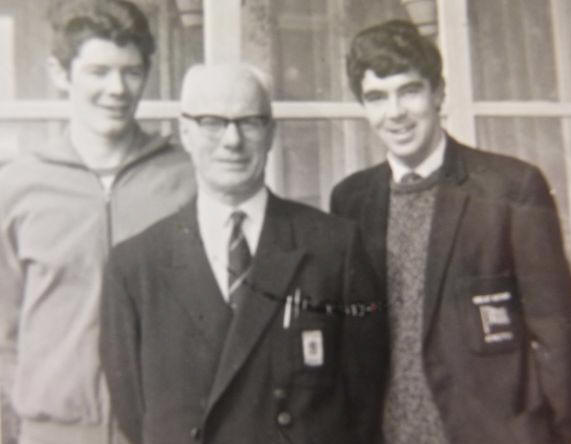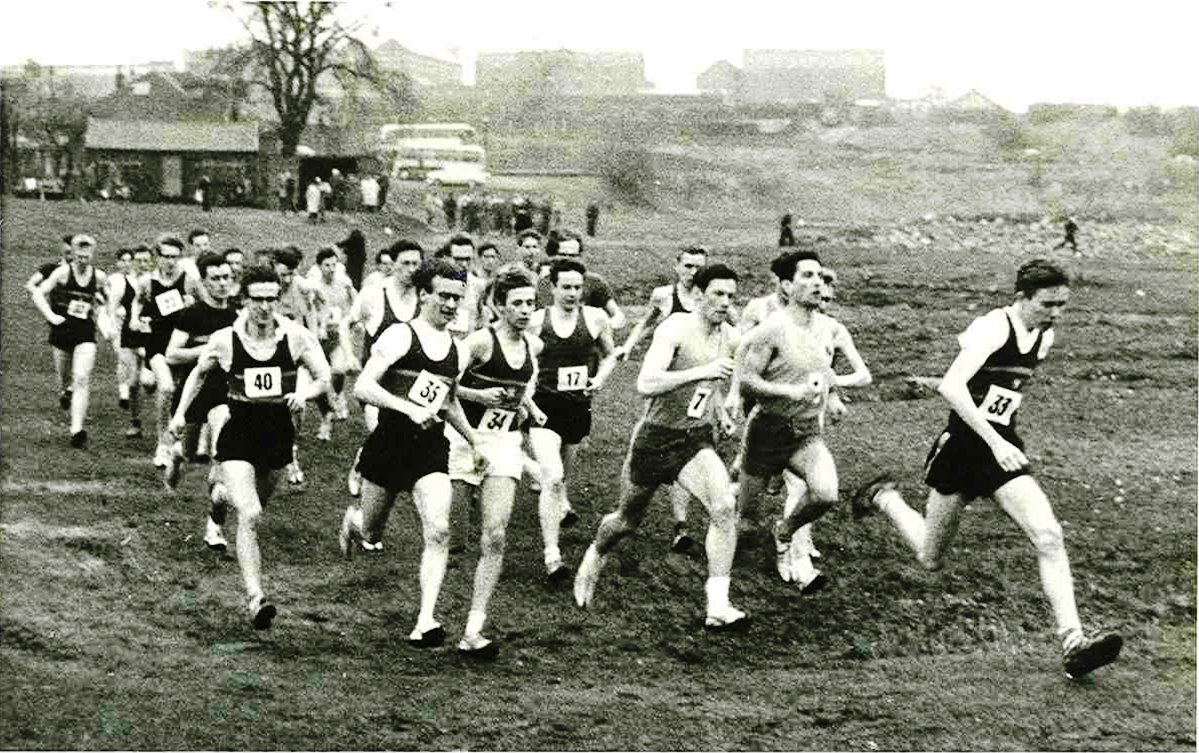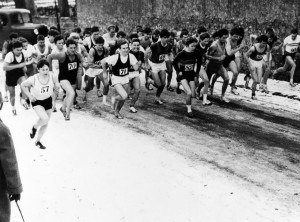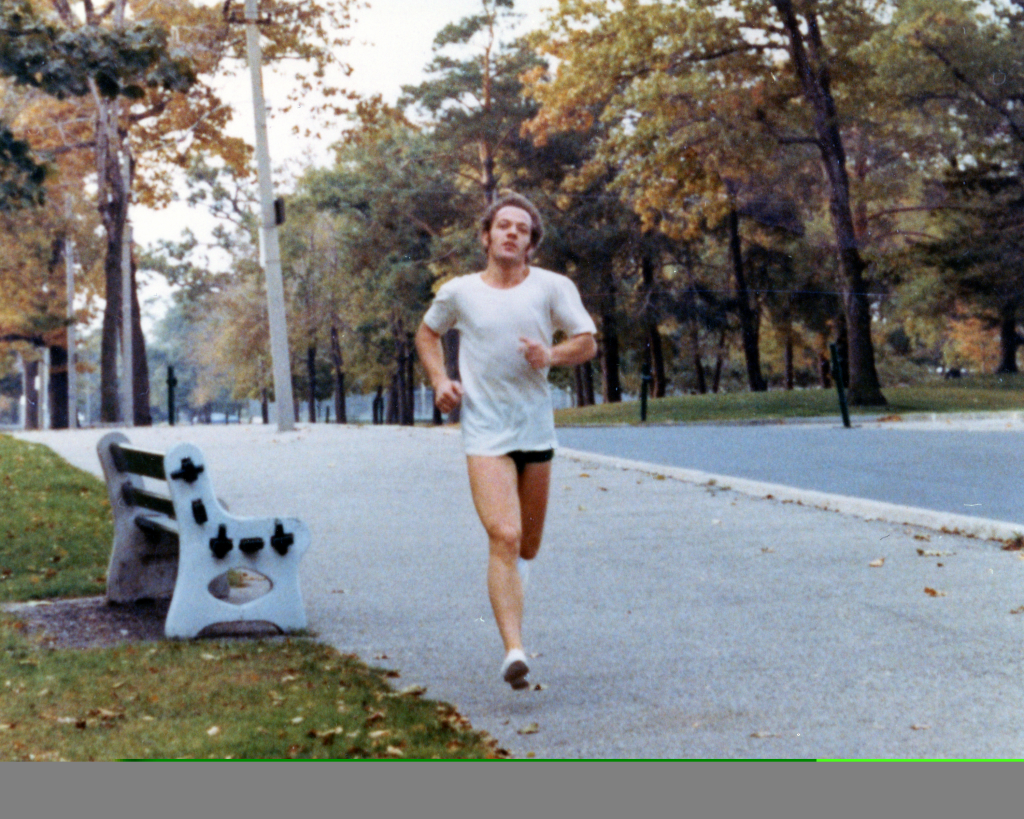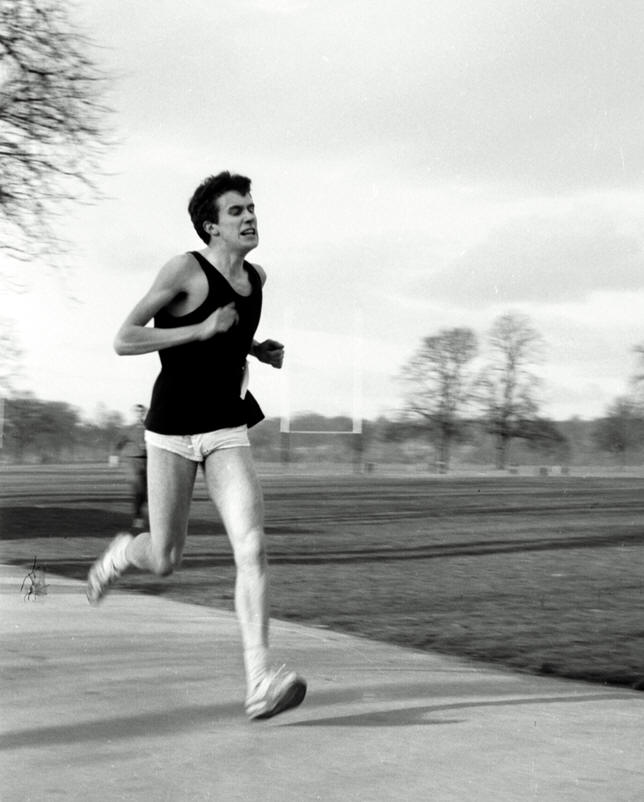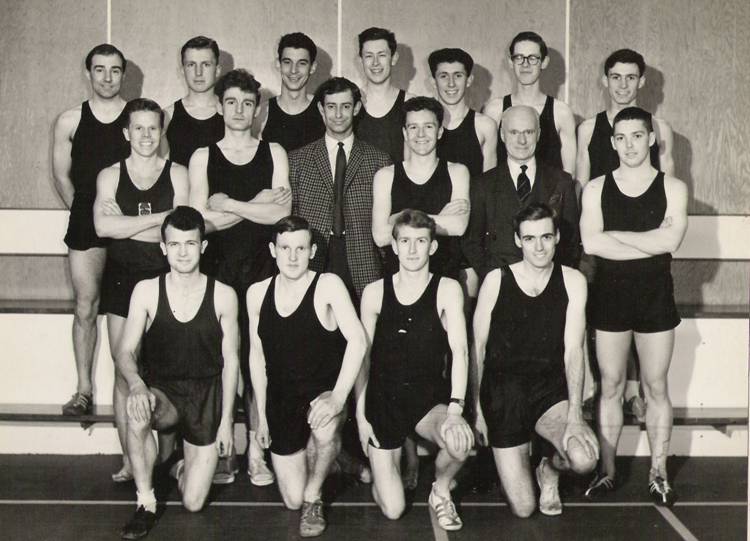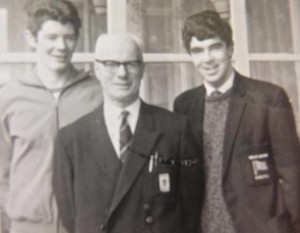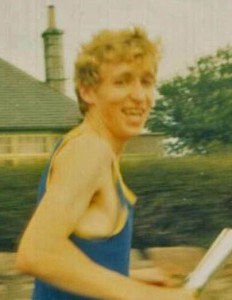
After turning 65, I wrote an article entitled ‘Running Every Stage’. Stage Two covered my time at university (between the ages of 18 and 23) and this extract follows. However it sounds a little vague, so a kaleidoscope of assorted memories will be added afterwards.
Stage Two: Gaining Speed.
You glean so much information about running during five years at university. For a start, the cross-country men form a proper club, with first and second teams, hopefuls and older chaps. There is a real tradition, a history. Previous members ran for Scotland or even Britain. Ahead stretches an excellent programme of races against different pairs of universities, culminating in championship events: Scottish Unis, BUSF, East District and the National itself. Plus the amazing Edinburgh to Glasgow Road Relay. Train or bus travel is fully subsidised.
By the mid-1960s, there are complex recipes for training (but which ingredients will prove healthy for you?) For example, aerobic and anaerobic running; sand-hill sessions (soon discarded as a form of torture which fails to improve fitness for anything else); and weight-training (similarly dumped since skeletal older guys remain much faster). The training week takes shape around academic studies. You gradually start to get out every day of the week, if only for a wee jog.
Wednesday afternoon is the club run (six or ten miles), and as fitness increases, you manage to hang on a bit longer to faster men and to outpace other ‘freshers’. Tuesdays or Thursdays might be the day for reps: either twenty times 220 yards (brisk but controlled) or four times 660 (lactic acid up to your brain). There are races nearly every Saturday, over many types of terrain. You discover that easier courses suit you, while mudlarks enjoy sticky, tricky land. Yet to gain a ‘blue’ is an achievable aim, so you try hard anyway. Giving up is a crime. After races, whatever the result, it is time for beer-drinking and badinage. Nonchalance is mandatory; swollen egos will be satirised mercilessly. By the end of First Year, you feel strong enough to take your Sunday morning hangover along to the long run, which is organised by the city’s best distance athletes. This pack session is fast from the start, and the normal loop is fifteen miles. Devil take the hindmost: when you are dropped, don’t expect anyone to wait for you. More sarcasm than sympathy is offered, which hardens resolve for future improvement, until you can be the revengeful, merciless, sadistic one!
Only about forty miles per week is averaged, but as the months pass, you do get better, as is proven during the short summer track season, when you concentrate on doubling up (one mile and three mile races) and post new best times. Then you enjoy the track events at Highland Games before going camping, youth hostelling and earning cash by working at a summer job. Due to the resilience of youth, injuries are seldom encountered. When they do occur, you simply rest a couple of days and then try to jog back to fitness. Physiotherapy is unavailable (and will continue to be absent or ineffective until the 1980s or later).
Your university first team is friendly, determined (in a cavalier fashion) and quite successful, but certainly not the best. You decide to increase training, hoping to compete properly with stars from bigger cities. Progress is not ceaseless. Sometimes you overdo the training and pick up some infection; or fall over in the mud; or hurt some muscle or pull a hamstring. You produce good, bad and average performances, goodness knows why. It is all experience and your training diary is frequently reviewed, to locate the magic formula for guaranteed success …..
By Third Year, you are a senior university runner – full blue, SU representative, club captain. Apart from the usual competitions, you take part in longer track races (including the Track Ten) plus occasional Highland Games road or hill races. Then, at the age of 21, it is legal to attempt your first marathon, which you complete cautiously but quite well. It is clear that road is your preferred surface; and it may be that in future the marathon may be your best event. But you are well aware that fitness over 5000m (yes, race distances have gone metric) is key to speed at everything from 1500m to 26 miles 385 yards (sorry, 42 kilometres 195 metres).
Swotting for that degree stalls athletic improvement but during your final, post-grad year the trend becomes favourable once again. When you leave university and start work, can you really produces what some call ‘lifetime bests’ (as if these can happen some other time) or have you run these already?
Motivation: ambition, improvement, achievement, targeted rivals, trying very hard not to let the team down (especially in the E to G), exploring different events.
ASSORTED MEMORIES
Joining Aberdeen University Hare & Hounds Club during Freshers’ Week and then receiving a letter of welcome from the Captain, John Aberdein, who remains a good friend almost fifty years later.
A few of the speedier, older Harriers did not condescend to speak to mere first years. I vowed to improve and beat them. Otherwise it was a friendly club, a mix of folk who just enjoyed running and a few who became addicted to training and becoming faster.
Entering our dressing room: bare wooden floor, benches, pegs and hot pipes, around which a few less hygienic runners wrapped their sweaty, grubby vests. The stench! Hot blackcurrant drink in the Art Deco pavilion café. Note that our racing attire involved blue shorts, and vests that were officially described as gold or amber, not proletarian yellow!
King’s College field 1966-1971. A hallowed stretch of turf, with pitches (according to the season) for football, hockey, rugby or cricket) and in summer a good grass track. We warmed up round the perimeter; ran 660 yard repetitions; or 220s either on the track or up and down the bottom straight. Scottish National Coaches John Anderson and then Frank Dick introduced us to the hell of 20-second runs! Lactic acid over your head.
Our home cross-country course. Starting by St Machar’s Cathedral, over cobbles, up an alley-way, right onto a road, left up a hill, right down some dangerous metal steps, over a swaying wooden bridge, right along the Don footpath, left up a steep bank onto Balgownie fields, right onto the road, a long swinging downhill to the Bridge of Don, shooting across and up a narrow dead-end roadway past Balgownie golf course, left over an undulating dune path, right onto the sand itself, trying to keep on the damp, harder surface near the North Sea, up and back along the roadway, shooting across the main road again, utterly ignoring traffic, right along a Don footpath, down a muddy hill, up over cobbles, through a green gate, onto another Don path, high over smelly emerald waters, down into Seaton Park, a long straight and then left again to sprint up a steep slope to the finish, back near St Machar’s again. In theory, six-and-a-half miles; probably a little less. Bill Ewing had the record (33.27); John Myatt of Strathclyde took a second off it; and in my final year, I got frustratingly close with 33.29 in the Christmas handicap!
Training. Those dreadful sandhill repetitions at Balmedie, soon abandoned, thank goodness. Mel Edwards pioneered a five-mile circuit from the pavilion right round the Beach golf course. (On one occasion I just managed to keep up with Mel on this route, due to typically non-stop vocal encouragement. However it transpired later that he was completing the course for the fourth time that day, with one more to do that evening!) Another popular five mile run was out King Street to the Bridge of Don, along the dunes to ‘The Boats’, and back via sand and pavements. Alternatively, golf course fartlek round the edge of Balgownie and Murcar, ten miles in all. An early move towards long distance efforts was the Scotstoun run, out the undulating road of the same name, and then taking an arc down towards the sea, finishing once again on golf course and pavement – thirteen miles, allegedly. Our own half marathon, for the unusual Sawfish Snout Trophy, involved two times round the cross-country course.
Before AU minibuses were invented, we took (subidised) trains and buses to cross-country races against either two or six other university teams (there were only seven, before Stirling was created). St Andrews (hilly, I needed a tetanus injection after vaulting a gate and spiking myself on rusty barbed wire). Dundee, either Camperdown or Caird Park. Glasgow, Westerlands might include canal towpaths or serious mud. Strathclyde, an even muddier course. Heriot-Watt, can’t remember. Edinburgh, from King’s Buildings, down a steep road hill, right up a farm track and then up, up and away to the top of the Braid Hills golf course before a nasty descent and a short uphill finish.
The green vests of Edinburgh University Harriers dominated lead packs during that period. Scottish and British Universities Champions, Scottish Senior National Champions, Edinburgh to Glasgow Road Relay winners. In 1967, Scottish Unis CC Champs took place over their KB/Braids course. It was misty near the top. Eight EU guys and John Myatt entered the fog; only EU returned (although John did survive the mugging to finish 9th). In the Second Team race, Chris Elson (EU) won, in a time faster than Myatt’s in the First Team race. How’s that for supremacy? We seldom beat any of those men, but what an inspiration to train harder! Fergus Murray had left; leaving Gareth Bryan-Jones, Alistair Blamire, Ian Young, Dave Logue, Alex and Jim Wight and other top-notch athletes.
Strathclyde and Aberdeen vied for second-best team. At least Strath could drink as much beer as Edinburgh, or even more. We tried to down more but failed.
Friendly rivalry with Irish Universities: Queen’s Belfast; Trinity and UCD in Dublin. They visited us one year and we toured there next year. Irish Tours were always great adventures, but rather tiring, not only because of two successive races, but mainly because of the booze and lack of sleep. The Mursell Trophy was contested between AU and QUB. By the time I left in 1971, somehow I had succeeded in finishing first in that match, once in Belfast and once (by only 10 seconds) in Aberdeen. We usually won the team cup. Guinness tasted okay in Aberdeen, better in Belfast and wonderful in Dublin, especially once when we stayed in Trinity quadrangle after the race and our hosts supplied free barrels of the stout. Robin Orr (son of the manse in Ratho) and I, two comparatively limited imbibers, staged an inexpensive contest and accepted a tie after ten pints each. Not drunk, we assured each other solemnly, just full up! Once, AU runners were in a Belfast pub. Someone suggested a fast pint competition. Charlie Macaulay (good runner from a rural background) won in about three seconds, although he seldom drank alcohol. “How on earth did you do that, Charlie?” “Pretended I was back home, drinking fresh milk!” I seem to remember Merv McIntyre organised a minibus Irish tour along especially strict guidelines: one bag per person only, which had to be put on the roof-rack; and inside only runners, sleeping bags for sitting on, plus food, booze, newspapers and commando comics!
Another bright memory was when Donald Ritchie, Charlie Macaulay, Bob Masson, Kerr Walker, Brian Templeton and I competed in Nos Galan, a wonderful Welsh four-mile road race that started ten minutes before midnight and finished in the New Year of 1971. Kerr was already in Wales, but the rest of us drove down in a crammed car, with the boot full of running kit, beer cans and three bottles of whisky. Snow was encountered from Aberdeen to Stonehaven and then later in Snowdonia but fortunately not between those points! Amazingly we ran well and won trophies for third team. Dave Bedford broke the record. 231 finished and the top 100 had their names read out, raised an arm and had a blood-red Nos Galan vest thrown at them from the stage! Then we annoyed various Cornish and Englishmen in the hostel by staying up drinking until 6 a.m.
A major event every November was the Edinburgh to Glasgow Road Relay. AUH&H usually ran fairly well but the highlight was in 1970, when we squeezed into the top ten to finish ninth from the 20 invited teams. Not bad, considering that all the best Scottish runners took part. Our lads that day, in running order, were: Don MacIntosh, me, Charlies Aithie and Macaulay, Jim Rough, Don Ritchie, Robin Orr and Merv McIntyre. There was a good competitive spirit amongst the first team; but the wilder lads in the second team (i.e. ‘The Rearguard’) usually took the lead socially.
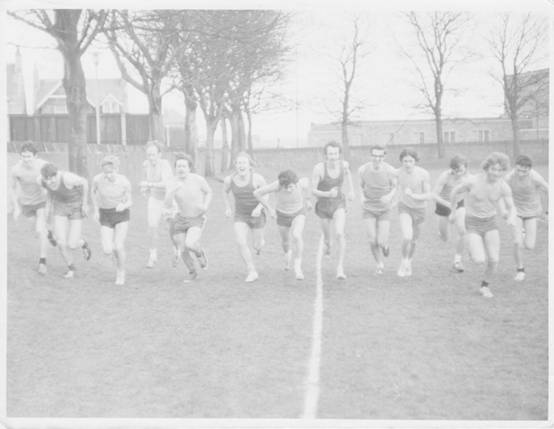
(Some of the 1970 First Team and Rearguard posing for an action photo)
The best AU cross-country runners during my time were: Dave MacFarquhar in 1966; Bob Hay in 67; Jim Maycock in 68; and then, when I became Captain, bloody Donald Ritchie arrived! He was running more than 100 miles per week even then, while I could only manage 40, so he beat me over the country, while I occasionally got past him on road or track. So I never won the Championship Cup, boo-hoo. Donald went on to become one of the world’s finest ultra-distance runners. Despite all those defeats in the mud, I still consider him a very good friend, along with Innis Mitchell, of Aberdeen AAC, and Glasgow and Strathclyde Universities.
Scottish Universities fielded an eight-man team against other regional ones in the British Universities CC, which seemed to be always run through mudbaths like Graves Park, Sheffield or Parliament Hill Fields in London. Every December, SU also ran against the Scottish Cross-Country Union Select, usually near Glasgow or, latterly, at Stirling University. At least it was a chance to see just how good Lachie Stewart and Dick Wedlock actually were.
In summer, we ran for AUAC, wearing a blue vest rather than a yellow one. Once again, it was a case of matches against two other universities or all seven. I once led a 1500 metres (yes, in 1969 we had gone metric!) until thirty yards from the tape, when a very young Frank Clement (future Olympic finalist) whizzed past. SU once cobbled together a team against Irish Universities and Belgian ones in Dublin. The annual highlight was the Rowland Trophy meeting in Durham, where we competed against lots of English universities as well as Scottish ones. Then there was our own AU sports day. I organised it in 1971 and included a paarlauf mile. Bob Anderson and I took considerable pleasure from recording 3.57!
Club reports, in ‘Gaudie’, the AU student newspaper, were usually witty and always disrespectful, as were the yearly sections in ‘Athletic Alma’. Unless you could take ridicule, or dish it right back, it was best to remain studying in the Library.
Filling out Blues Forms was an art in itself, involving working out your average position in races against each individual rival university, plus placings in SU or BUSF or East District or Scottish championships. For Athletics, you had to pay attention to Scottish Standard times in various events. To obtain a Blue for cross-country was comparatively straightforward, if you managed to defeat nearly all your own men plus most from weaker universities. Athletics was more difficult. During my post-grad year, in a final effort to attain Full Blue status, not only did I run 1500/5000 doubles, but also the steeplechase, 10,000 metres, Ten Mile Track and marathon! Only Bill Ewing, sartorially elegant, had the nerve to sport the exotic powder-blue blazer. Yet several of us liked to wear SU or Blues ties or even scarves, embroidered in white by Esslemont and Mackintosh. Entirely unfashionable nowadays!
In April 1970, eight of us tried to make the Guinness Book of Records by running a sponsored relay round King’s field for three whole days and nights, completing no fewer than 636 miles, 1320 yards. Sadly, Norris McWhirter turned us down but at least he sent an autographed letter. At that time, the reward for raising £100 for the Student Charities Campaign was a barrel of beer. Since we contributed more than £300, our problem was trying to consume three barrels (i.e. 244 pints) at one party. Donald MacIntosh’s speciality was standing on his head, feet against the wall, while drinking a pint upside down!
A final memory is of AUH&HC AGMs at The Mill Inn, eight miles out the South Deeside Road. Traditionally, the pre-meeting run involved a mazy wander over uncharted fields and hills. Frequently we became lost and struggled back after 13 miles or more, so the review of the year and voting for club officials took place in a tired, beery haze.
Aberdeen University gave me not only a good education, but also a successful apprenticeship, which developed more confidence in social circumstances as well as in my chosen sport. Most of the time, what fun we had!
